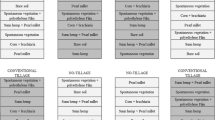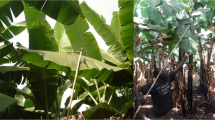Abstract
Poor root syndrome (PRS), a major disease of sugarcane in Australia was reduced by the use of minimum-tillage planting techniques involving planting into the inter-row of the previous crop. Populations of pathogens and yields were compared with planting into the previous row and with conventional cultivation and planting. The density of oospores of Pachymetra chaunorhiza was always lower in the inter-row at planting. At one site, planting in the previous inter-row gave 14% higher yields than planting into the previous row in the Pachymetra root rot susceptible cultivar Q90. The Pachymetra root rot resistant cultivar, 4138, yielded 6% more when planted in the interrow compared with planting in the previous row. The density of oospores of P. chaunorhiza in the row was ten times higher than in the inter-row at this site. At two other sites the oospore density was relatively low in both the row and inter-row and no difference in yield was found between the two planting positions. At a fourth site, high oospore densities were recorded in the row but the inter-row also had oospore densities above the threshold for maximum disease in susceptible cultivars. No yield difference was measured between the planting positions at this site. There was no advantage from conventional cultivation at the two sites where this treatment was included.
Similar content being viewed by others
References
Burgess, D.J.W. (1986) — Innisfail growers use minimum tillage planting. BSES Bulletin 13: 20–21.
Chandler, K.J. (1984) — Plant parasitic nematodes and other organisms as a contributing factor to poor sugarcane root development in north Queensland. Proceedings of the Australian Society of Sugar Cane Technologists 6: 63–68.
Croft, B.J. (1989) — A technique for screening sugarcane cultivars for resistance to Pachymetra root rot. Plant Disease 73: 651–653.
Croft, B.J., Chandler, K.J., Magarey, R.C. and Ryan, C.C. (1985) — Northern poor root syndrome of sugarcane in Australia. In Ecology and Management of Soil-borne Plant Pathogens (Eds C.A. Parker, A.D. Rovira, K.J. Moore, P.T.W. Wong and J.F. Kollmorgen), pp. 17–19. APS Press.
Croft, B.J. and Magarey, R.C. (1984) — Pathogenic fungi associated with northern poor root syndrome of sugarcane. Proceedings of the Australian Society of Sugar Cane Technologists 6: 55–61.
Croft, B.J. and Magarey, R.C. (1989) — A review of research into Pachymetra root rot, an important new fungal disease of sugarcane. Proceedings of the International Society of Sugar Cane Technologists 20: 686–694.
Croft, B.J., Reghenzani, J.R. and Humey, A.P. (1984) — Northem poor root syndrome of sugarcane — studies on soil transmission and the effects of various fungicidal, nutritional and agronomic treatments. Proceedings of the Australian Society of Sugar Cane Technologists 6: 69–77.
Egan, B.T., Hurney, A.P., Ryan, C.C. and Matthews, A.A. (1984) — A review of the northern poor root syndrome of sugarcane in north Queensland. Proceedings of the Australian Society of Sugar Cane Technologists 6: 1–9.
Gillaspie, A.G. Jr. and Teakle, D.S. (1989) — Ratoon stunting disease. In Diseases of Sugarcane — Major Diseases (Eds C. Ricaud, B.T. Egan, A.G. Gillaspie, Jr., and C.G. Hughes), pp. 59–80. Elsevier, Amsterdam, The Netherlands.
Holmes, J. and Verri, R.D. (1988) — Crop establishment at Mossman with minimum till planting and chemical ploughout of the previous crop. Proceedings of the Australian Society of Sugar Cane Technologists 10: 153–155.
Iggo, G.A. and Moberly, P.K. (1976) — The concept of minimum tillage in sugar cane. Proceedings of the South Afiican Sugar Technologists Association 50: 141–143.
Magarey, R.C. (1989) — Quantitative assay of Pachymetra chaunorhiza, a root pathogen of sugarcane in Australia. Phytopathology 79: 1302–1305.
Magarey, R.C. (199la) — Pachymetra root rot of sugarcane. PhD. Thesis. The University of Queensland.
Magarey, R.C. (1991b) — The effect of varietal resistance on the epidemiology of Pachymetra root rot. Proceedings of the Australian Society of Sugar Cane Technologists 13: 95–102.
McIntyre, G. and Barbe, C. (1989) — The effect on sugarcane yield, weed control, physical and chemical properties of the soil of minimum tillage vs normal mechanical tillage. Proceedings of the International Society of Sugar Cane Technologists 20: 586–590.
McMahon, G. (1987) — Options for planting techniques. BSES Bulletin 18: 10–14.
Author information
Authors and Affiliations
Rights and permissions
About this article
Cite this article
Croft, B.J., Saunders, M.R. Reducing poor root syndrome of sugarcane in Australia by minimum-tillage planting in previous inter-rows. Australasian Plant Pathology 25, 192–198 (1996). https://doi.org/10.1071/AP96033
Received:
Accepted:
Issue Date:
DOI: https://doi.org/10.1071/AP96033




